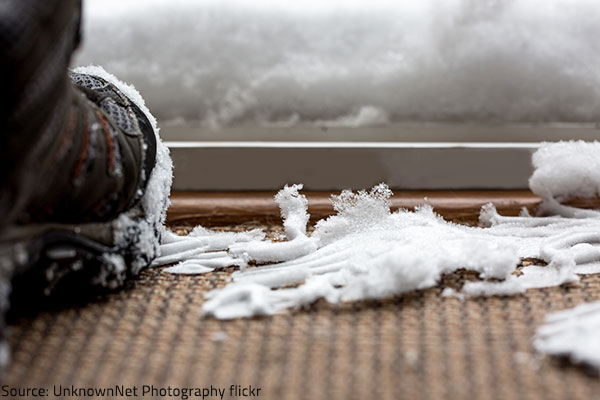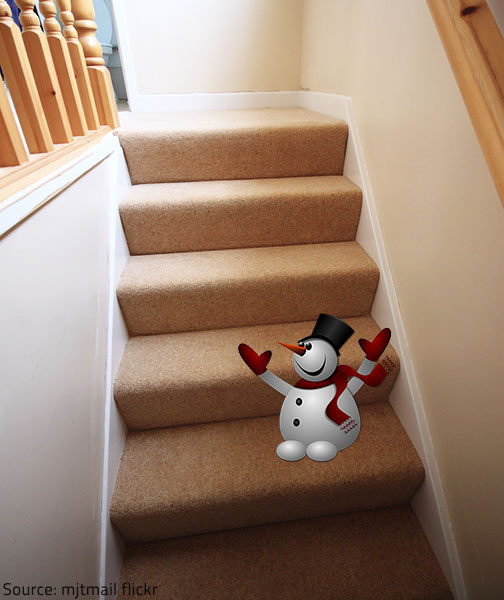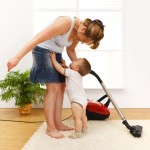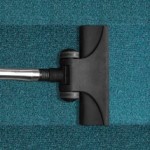
Unlike accent furniture pieces, extravagant lighting fixtures, or any other fancy furnishings, the carpets in your home or commercial area are not intended to delight or to impress – they are nothing more than a background to your interior décor. Yet, it is the general appeal of such background features that sets the atmosphere in the room and defines the ambience of the property. If your carpet is in poor condition and looks worn-out, faded, or soiled, your entire facility will seem unattractive and untended. Therefore, you need your carpets to look their best all the time, regardless of the current weather conditions, daily foot traffic, and ongoing activities in the building.
Proper maintenance will, of course, help you extend the useful life of your carpeting and keep it looking fresh and charming for many years. Simple protective measures, timely removal of spills, and regular vacuuming are usually enough to ensure the good condition of your carpet. However, when winter comes, carpet maintenance becomes much more of a challenge as snow, mud, salt, and debris are tracked inside on daily basis, affecting the look and feel of the fabric floor coverings. Unless adequately taken care of, the excessive moisture and the accumulated dirt will quickly result in unsightly stains and permanent damage to your carpets. So, you need to adjust your carpet care practices to the changing ambient conditions and find an efficient way to keep your carpeting clean and free of damage during the winter months.
The following easy-to-follow tips for effective winter carpet care may be exactly what you’ve been looking for:
1. Identify the Areas that Need Special Attention
Some of the areas in your property are more vulnerable to the changing atmospheric conditions than others – your outdoor space, the entrances to your building, the first 20 to 30 feet inside, the stairs, etc. If you take effective measures to protect these areas from excessive moisture and soiling before the onset of winter, you will considerably reduce the potential risks for your carpets. So, take into account the particular circumstances in your case and make every possible effort to prevent your carpeting from getting dirty, stained, and/or damaged.
Also, have in mind that certain carpeted areas (such as entries, hallways, high-traffic areas, etc.) will need more frequent (and more careful) cleaning during inclement weather and monitor them daily to be able to respond adequately to their changing needs.

As a matter of fact, it is quite a good idea to develop and implement a weather-specific cleaning and maintenance plan, so that your carpets can survive the winter in excellent condition.
2. Prevent Soiling in the First Place
As it is always the case, prevention is the best way to deal with a problem. So, instead of wondering how to remove mud, salt, and debris from your carpets, do your best to keep dirt off the floors – capture soil at its source and prevent it from tracking in and around the facility.
- Keep the exterior of your home or commercial building clean. Sweep walkways and garden paths on a daily basis, keep the parking lots clean, shovel the accumulated snow, and use a snow blower to remove as much soil, sand, slush, snow, and ice from your outdoor area as possible. This way, you will prevent debris and salt from being tracked inside as you and your family members, your visitors, clients, or employees, etc. enter the building;
- Invest in floor matting. Place door mats both inside and outside every point of entry to your building (wiping your feet off twice will help remove excess moisture, dirt, or salt from your shoes). Make sure the floor mats cover at least 12 to 15 feet inside and outside the entrances, so that they can efficiently absorb moisture and prevent soil from getting on your carpets;
- Wear indoor shoes inside your home. You are strongly advised to take off your shoes as soon as you enter your home, especially during inclement weather. Store them on a boot tray that will keep slush and sand away from the floor and make sure they don’t get accidentally kicked or moved around, as the dirt from the soles may loosen and spread into your home. It is also a good idea to provide several extra pairs of indoor shoes of different sizes to offer to your guests;
- Clean your pets’ paws. If your animal friends have been out in the snow or if their paws are covered in mud after a walk on a rainy day, you need to take some precautionary measures before they enter your home. Make your dog or cat stay for several minutes on a door mat made from an absorbent microfiber material that can wick away water from their paws and use wet wipes to clean your pet’s paws, belly, chest, and tail, so that no dirt, snow, or sand is tracked inside.

Sometimes, using hot water extraction, carpet steam cleaning, or other professional cleaning techniques is the only way to restore the excellent condition of your carpets.
3. Vacuum Frequently
Regular and frequent vacuuming of high-traffic areas is the easiest and most effective way to prevent excessive accumulation of dirt and debris, reduce wear and tear on your carpet, and prolong its life. Make sure your vacuum has a HEPA air-filtration system, so that it keeps the indoor air clean while efficiently removing dry soil from the carpet.
It is recommendable to vacuum your carpets 2-3 times a week during the winter because salt that is left to sit on the surface will act like a piece of sandpaper each time you walk over it and will cut away at the fibers of the carpet. Timely dry soil removal, on the other hand, will reduce the need for deeper cleaning and will contribute to the fresh and aesthetical appearance of your carpets.
4. Take Care of Stains As Soon As You Notice Them
Don’t wait for muddy footprints to dry or for dirty stains to settle into the carpet fibers – remove any visible spots as soon as they appear. The longer they stay on the carpet, the more likely they are to become permanent (besides, the dirt may spread further into the building).
There is a great variety of general purpose and specialty stain removal products you can choose from in order to get rid of spots on your carpet. Be careful, though, as using inappropriate cleaning methods or products may damage your carpet or result in permanent staining. A mixture of warm water and white vinegar will often do the trick when it comes to removing or reducing salt stains (the most common type of stain that occurs in residential and commercial facilities in the winter period). All you need to do is mix equal parts warm water and white vinegar in a spray bottle, spray the stained area, wait for several minutes, then stir the salt to the surface by blotting with a clean cloth or using a brush, and, finally, press a dry towel over the area. Once the carpet is dry, vacuum it carefully to remove any remaining salt.

If the stain is too persistent or if your carpet is made of delicate materials, consider hiring carpet cleaning services – the experienced technicians have the advanced equipment and the required know-how to safely and efficiently restore the excellent condition of your carpeting.
5. Get Rid of Salt and Chemical Residues on Your Carpet
Salt and harsh chemicals that are commonly used to melt ice on the roads in the winter are extremely harmful to carpet fibers. When tracked inside, such de-icing products may not only stain, but also damage your carpeting. So, to prevent further troubles, you need to remove salt and chemical residues from your carpets or floor matting as quickly as possible.
First, vacuum the area in order to remove any dry soil and then follow with multiple wet extraction rinses for maximum efficiency. Professional carpet cleaners usually pre-spray the stained area or add a hard-surface floor neutralizer to the carpet cleaning rinse water in order to achieve the best possible results.
This carpet cleaning method is quite laborious and time-consuming, but it is your best defense against tracked-in soil, sand, salt, and moisture. If you are not up to the challenge, hire professional cleaners to do the job for you – you will have your carpets cleaned and refreshed in the quickest, safest, and most efficient manner possible.
Even if your carpets are not severely stained, you are recommended to have them professionally cleaned at least twice a year. Hot water extraction, carpet steam cleaning, and other professional cleaning techniques (appropriate for the type of carpets you have in your building) will not only keep your fabric floor coverings clean and fresh, but will also help revitalize them and prolong their life.
6. Adopt Effective Carpet Cleaning Practices
The above-described winter carpet cleaning tips will help you save lots of time, money, and nerves, as you won’t have to deal with heavily stained and/or damaged carpeting. To ensure the excellent condition of your floor coverings throughout the cold season, however, you need to adhere to a few essential rules as well:

- Take good care of your entry matting – change door mats when they become dirty and/or saturated. Have in mind that if wet matting is not removed on time, it may become a source of soiling – instead of absorbing muddy water and residues, it will contribute to their spread further into the building. So, wash your floor mats every other week or so (or more often, if deemed necessary), speed dry them, and vacuum them thoroughly before putting them back in their places;
- Clean the lower floors first – it is only natural that most of the dirt and moisture tracked into your building will be “captured” by the carpets on the first floor. If you vacuum the lower floors on a frequent basis, less soil will travel throughout your facility and the carpeting on the upper levels will stay clean and fresh much longer. Therefore, keeping the lower floors of your building clean and spotless should be among your top priorities;
- Pay special attention to stairs and elevators – dirt collects easily on stairs and elevators, so you need to vacuum these areas often in order to prevent soil from spreading throughout your building;
- Come up with an efficient, weather-specific cleaning plan – your winter cleaning program should include not only more frequent low-moisture surface cleaning, but also occasional deep cleaning (wet extraction). Whenever your carpet is heavily soiled or excessively wet, interim cleaning won’t be effective enough. In such cases, you need the professional assistance of experienced carpet cleaners in order to restore the good condition of your carpeting.
To have your carpets looking at their best even in the harshest season, you need to allocate adequate labor, equipment, and budget to your carpet cleaning program. The astonishing results will be worth it!





